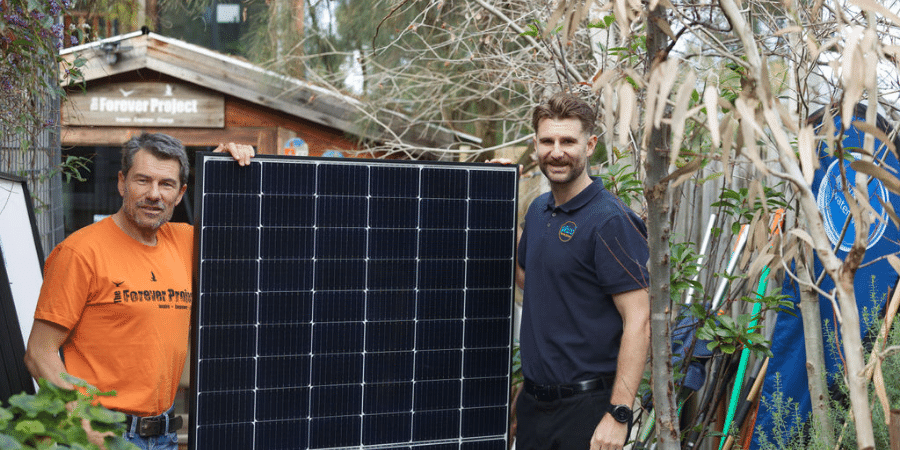Solar panels can be recycled in Australia if they are disposed of correctly. In most parts of the country, panels need to be disposed of as e-waste, or given to a special solar panel recycling facility. From there, they are broken down and reused for a number of different products. Recycling solar panels helps protect the environment by keeping them out of landfill. However, the recycling process is relatively new and can be expensive, leaving some Australians to turn to cheaper landfill options. On the bright side, solar panel recycling facilities are slowly appearing across the country as more Aussie households adopt solar.
Are solar panels recyclable?
Solar panels are up to 95% recyclable. They are broken down into separate components like glass and silicon to be reused. Many Australians aren’t aware that solar panels are so recyclable, partly due to their long lifespans (solar panels last up to 25 years). However, it’s becoming increasingly important to understand what to do with your panels once they expire, since many Australian states, such as Victoria and South Australia, have banned solar panels from landfill. This results in many Australian solar users discarding their panels as e-waste, which has the potential to be harmful when treated inappropriately. It also means that materials are going to waste instead of being reused for other products that require silicon, aluminium, and other metals found in your panels.
Why do we need to recycle solar panels?
The most obvious reason we need to recycle solar panels is to keep solar energy sustainable. Installing solar panels is one of the first steps toward a cleaner and greener future, and so is recycling. Like most products, solar panels have a finite lifespan, so it’s a good idea to be aware of your disposal options once they expire. By choosing to recycle, you’re not only doing your bit to reduce landfill, you’re also closing the loop on solar power and making the process even more sustainable.
Solar panel lifespan
Solar panels could last up to 25 years. The lifespan of solar panels is dependent on a number of factors, such as weather, energy usage, quality and general degradation over time. Solar panels could also be damaged by falling branches, rocks, or salt (if you live in or near coastal areas). That means they’ll need to be replaced at some point. With over three million small-scale solar PV panel systems installed since 2001, many households will be due for a replacement or upgrade. If solar users are unaware of the options surrounding solar panel recycling, they may end up wasting valuable resources.
Environmental impact
Recycling solar panels is a great way to reduce your environmental impact. Solar power is a renewable energy source, meaning it doesn’t deplete and can be used over and over again. Other energy sources, like fossil fuels, need to be extracted from the earth and burned, releasing large amounts of carbon dioxide, which harms the environment. Since installing solar panels already reduces your carbon footprint, it makes sense to keep the ball rolling and dispose of them carefully as well. Solar panel materials are potentially harmful to the environment if they end up in regular landfills, so simply throwing them away is not an option.

How to recycle solar panels?
Recycling solar panels involves a careful process of separating their materials and retaining their high purity. This is typically done with machinery. From there, the different parts are reused, but only when the proper recycling process is carried out.
How are solar panels disassembled for recycling?
To disassemble solar panels for recycling, they typically go through a shredding machine. This breaks them down into smaller pieces, so their materials are easier to separate. From there, panel components are carefully pulled apart using intense thermal processing. If they are contaminated by other materials, manufacturers may not accept them. However, new processes are being developed to further the efficiency of separating PV materials and retaining their purity so they are recycled effectively.
Can parts of the solar panel be reused?
Many parts of solar panels can be reused. Panels are mainly made up of glass, which is used for a variety of functions. Silver is highly sought after for mirrors or other reflective surfaces and even photographic paper and film. Recycled aluminium is found in car parts, furniture, aeroplanes, fences, and a range of other products. Solar panels also contain silicon, which is melted down and used as an industrial lubricant. It has also been successfully demonstrated that recycled silicon from PV panels can be processed into nanosilicon, a high-value product used to make lithium-ion batteries.
What is the cost of recycling solar panels?
Despite the benefits of recycling solar panels, the process may be quite costly for recycling facilities and solar users. Handing your panels to an e-waste facility may cost between $10 and $20 per panel. Not to mention, you’ll need to hire a removalist or solar panel recycling company to get the panels safely off your roof. On the side of recycling facilities, machinery is a huge cost factor. The process of recycling solar panels is expensive and time-consuming since parts need to be extracted carefully to avoid contamination. An ethical solar provider like Plico will remove your solar panels for you when you have a new system installed, and ensure your old panels are disposed of appropriately.
What are the challenges of solar panel recycling?
The main challenges of solar panel recycling are cost, awareness, and access. Solar panel recycling may be costly depending on how many solar panels you have and where your nearest recycling facility is. Many Australians are also unaware that solar panels can be recycled and that there are companies who will remove and recycle solar panels. There are only a few solar panel recycling facilities across Australia, which may prove inaccessible for those in remote areas, making the cost of recycling exceed the benefits. However, with the growing uptake of solar energy and more awareness being raised about the positives of solar panel recycling, more options are becoming available. main challenges of solar panel recycling are cost, awareness, and access. Solar panel recycling may be costly depending on how many solar panels you have and where your nearest recycling facility is. Many Australians are also unaware that solar panels can be recycled and that there are companies who will remove and recycle solar panels. There are only a few solar panel recycling facilities across Australia, which may prove inaccessible for those in remote areas, making the cost of recycling exceed the benefits. However, with the growing uptake of solar energy and more awareness being raised about the positives of solar panel recycling, more options are becoming available.
The future of solar panel recycling
Despite the challenges, the future of solar panel recycling is looking bright for Aussie households. In Plico’s case, when the time arrives to replace or dispose of your solar panels, we make sure to find the most viable method available. However, Plico customers shouldn’t need to worry about replacements or disposals for a very long time (up to 25 years). Our panels are made to last, and Plico members get years of ongoing support to keep your panels functioning efficiently, and hassle-free. Now that’s peace of mind!
Chat to one of our switched-on team members on 1300 175 426 for more information about our solar + battery, solar only or battery only products and pricing.
Have a question about solar + battery?


